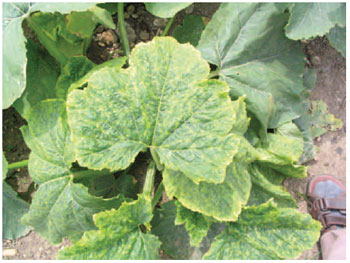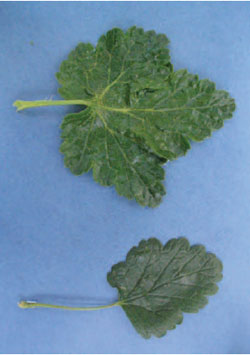Viruses
Content
Structure and biology Viruses are extremely small, much smaller even than bacteria (see Figure 15.2). The light microscope is unable to focus in on them, but they appear as rods or spheres when seen under an electron microscope. The virus particle is composed of a DNA or RNA core surrounded by a protective protein coat. On entering a plant cell, the virus takes over the organization of the cell nucleus in order to produce many more virus particles. Since the virus itself lacks any cytoplasm cell contents, it is often considered to be a non-living unit. Some details of its classification are given in Classification and naming. The virus’s close association with the plant cell nucleus presents difficulties in the production of a curative virus control chemical that does not also kill the plant. No established commercial ‘ viricide ’ has yet been produced against plant viruses. In recent years the broad area called ‘ virus diseases ’ has been closely investigated. Virus particles have, in most cases, been isolated as the cause of disease, e.g. cucumber mosaic. Other agents of disease to be discovered are viroids (e.g. in chrysanthemum stunt disease) and these are smaller than viruses. Mycoplasmas (the cause of diseases such as aster yellows) are a group of bacteria that induce symptoms similar to those produced by viruses. Spread: A number of organisms (vectors) spread viruses from plant to plant and then transmit the viruses into the plant. Peach-potato aphid is capable of transmitting over 200 types of virus (e.g. cucumber mosaic) to different plant species. The aphid stylet injects salivary juices containing virus into the parenchyma and phloem tissues, enabling the virus to then travel to other parts of the plant. ‘Persistent virus transmission ’ is seen in some vector/virus combinations such as peach-potato aphid/potato virus X, and Xiphinema dagger nematode/arabis mosaic where the virus is able to survive and increase within the vector’s body for several weeks. In many vector/virus combinations such as plum pox, the virus survives only briefly as a contaminant on the insect’s stylet. Other vector/virus combinations include bean weevils/broad bean stain virus; and Olpidium soil fungus/big vein agent on lettuce. Other important methods of spread involve vegetative material (e.g. chrysanthemum stunt viroid and plum pox), infected seed (e.g. bean common mosaic virus), seed testa (e.g. tomato mosaic virus) and mechanical transmission by hand (e.g. tomato mosaic virus). Symptoms: The presence of a damaging virus in a plant is recognizable to horticulturists only by means of its symptoms. For confirmation, they may need to consult a virologist, whose identification techniques include electron microscopy, transmission tests on sensitive plants such as Chenopodium species, and serological reactions using specific antiserum samples. Leaf mosaic, a yellow mottling, is the most common symptom (e.g. cucumber mosaic virus). Other symptoms include leaf distortion into feathery shapes (cucumber mosaic virus), flower colour streaks (e.g. tulip break virus), fruit blemishing (tomato mosaic and plum pox), internal discolouration of tubers (tobacco rattle virus causing ‘spraing’ in potatoes) and stunting of plants (chrysanthemum stunt viroid). Symptoms similar to those described above may be caused by misused herbicide sprays, genetic ‘ sports ’ , poor soil fertility and structure (see deficiency symptoms) and mite damage. In the following descriptions of major viruses, Latin names of genus and species are not included, since no consistent classification is yet accepted. Tomato mosaic
Life cycle and spread: The virus is a rod shaped virus. The period from plant infection to symptom expression is about 15 days. The virus may survive within the seed coat (testa) or endosperm of the tomato seed. It is very easily spread by human contact as it is present in large numbers in the leaf hairs of infected plants. Control: Heat treatment of dry seed at 70°C for 4 days by seed merchants helps remove initial infection. Infected debris, particularly roots, in the soil enables the virus to survive from crop to crop, and soil temperatures of 90°C for 10 min are normally required to kill the organism. Peat-growing bag and nutrientfilm methods enable the grower to avoid this source of infection. Hands and tools should be washed in soapy water after working with infected plants. Clothing may harbour the virus. Cultivars and rootstocks containing several factors for resistance are commonly grown, but newly arriving virus strains may overcome this resistance. A mild strain spray inoculation method has been used at the seedling stage to protect non-resistant cultivars from infection with severe strains. Great care is required to avoid mosaic-contaminated equipment when using this method.
Damage: Several strains of virus cause this disease. In addition to cucumber, the following may also be affected: spinach, celery, tomato, Pelargonium and Petunia. On cucumbers, a mottling of young leaves occurs (see Figure 15.20) followed by a twisting and curling of the whole foliage, and fruit may show yellow sunken areas. On the shrub Daphne oderata, a yellowing and slight mottle is commonly seen on infected foliage, while Euonymus leaves produce bright yellow leaf spots. Infected tomato leaves are reduced in size (fern-leaf symptom). Life cycle: The virus may be spread by infected hands, but more commonly an aphid (e.g. peach-potato aphid) is involved. Many crops (e.g. lettuce, maize, Pelargonium and privet) and weeds (e.g. fat hen and teasel) may act as a reservoir for the virus. Control: Since there are no curative methods for control, care must be taken to carry out preventative methods. Choice of uninfected stock is vital in vegetatively propagated plants, e.g. Pelargonium. Careful control of aphid vectors may be important where susceptible crops (e.g. lettuce and cucumbers) are grown in succession or next to other susceptible species. Removal of infected weeds, particularly from greenhouses, may prevent widespread infection. Tulip break The petals of infected tulips produce irregular coloured streaks and may appear distorted. Leaves may become light green, and plants become stunted after several years’ infection. The virus is spread mechanically by knives, while three aphid vectors are known: the bulb aphid in stores, the melon aphid in greenhouses, and the peach-potato aphid outdoors and in greenhouses. Preventative control must be used against this disease. Removal of infected plants in the field prevents a source of virus for aphid transmission. Aphid control in field, store and greenhouse further reduces the virus’s spread. Plum pox Damage: This disease, also called ‘Sharka’, has increased in importance in the British Isles since 1970 after its introduction from mainland Europe. Plums, damsons, peaches, blackthorn and ornamental plum are affected, while cherries and flowering cherries are immune. Leaf symptoms of faint interveinal yellow blotches can best be seen on leaves from the centre of the infected tree. The most reliable symptoms, however, are found on fruit, where sunken dark blotches are seen. Ripening of infected fruit may be several weeks premature, yield losses may reach 25 per cent, and the fruit is often sour. Life cycle: The virus is spread by several species of aphids. The speed of spread is quite slow because the virus is not able to live and multiply in the aphid. Movement of infected young plants is an important method of spread. Control: Preventative control is the only option open to growers. Clean Ministry-certified stock should be used. Routine aphid-controlling insecticides should be applied in late spring, summer and autumn. Suspected infected trees should be reported and infected trees removed and burnt. Chrysanthemum stunt viroid Damage: This disease, found only on plants of the Asteraceae family and mainly on the chrysanthemum, produces a stunted plant, often only half the normal size but without any distortion. Flowers often open one week earlier than normal, and may be small and lacking in colour. Life cycle: The virus enters gardens and nurseries through infected cuttings, and is readily transmitted by leaf contact and by handling. Control: Symptoms may take several months to appear, thus seriously reducing the chance of early removal of the disease source. The grower must use preventative control. Certified planting material derived from heat-treated meristem stock (see tissue culture) reduces the risk of this disease.
Arabis mosaic Damage: This virus infects a wide range of horticultural crops. On strawberries, yellow spots or mottling are produced on the leaves, and certain cultivars become severely stunted. On ornamental plants, e.g. Daphne odorata , yellow rings and lines are seen on infected leaves, and the plants may slowly die back, particularly when this virus is associated with cucumber mosaic inside the plant. Life cycle: Several weeds, e.g. chickweed and grass spp., may harbour this disease, and in strawberries severe attacks of the disease may occur when planted into ploughed-up grassland. The virus is spread by a common soil-inhabiting nematode, Xiphinema diversicaudatum , which may retain the virus in its body for several months. Control: Control of this disease can be achieved by preventative methods. Certified virus-free soft fruit planting material is available. Fumigation of soil with chemicals such as dichloropropene, applied well before planting time, eliminates many of the eelworm vectors. No curative chemical is available to eliminate the virus inside the plant. Reversion disease on blackcurrants Damage: This virus disease, caused by blackcurrant reversion virus can seriously reduce blackcurrant yields. Flower buds on infected bushes are almost hairless and appear brighter in colour than healthy buds. Infected leaves often have fewer main veins than healthy ones (see Figure 15.21). After several years of infection, the bush may cease to produce fruit. Life cycle and spread: The virus is spread by the blackcurrant gall mite, and reversion infected plants are particularly susceptible to attack by this pest. Control: Removal and burning of infected plants is an important form of control. Use of certified plant material, raised in areas away from infection and vectors, is strongly recommended. |
||||||||||||||||||||||||||||||







